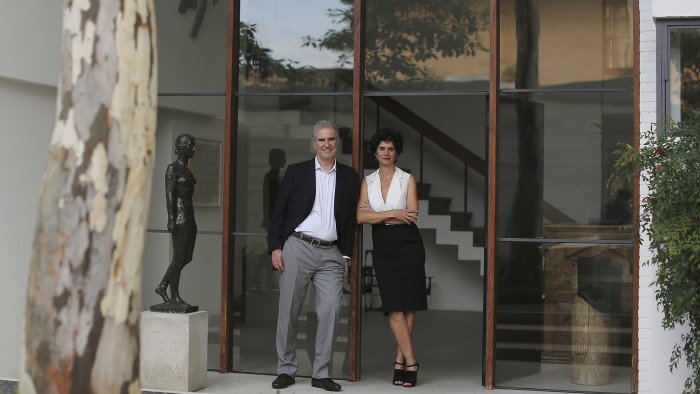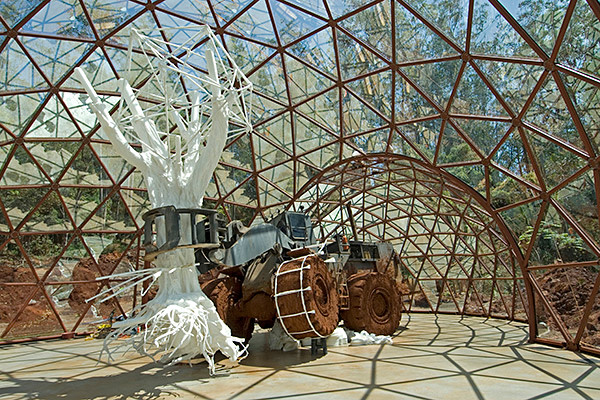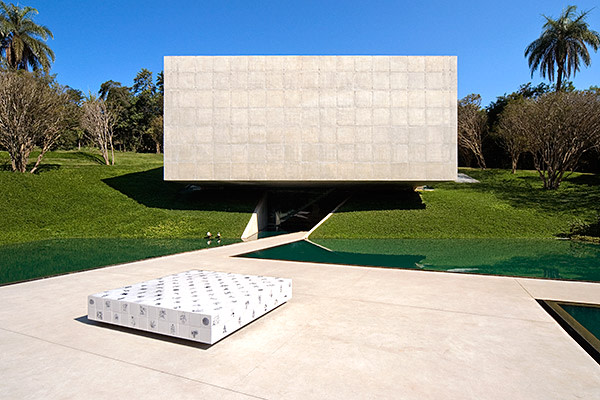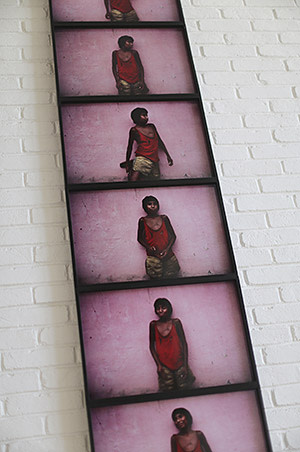Brazil’s new generation of wealthy art collectors

Roula Khalaf, Editor of the FT, selects her favourite stories in this weekly newsletter.
Pedro Barbosa thoroughly enjoys his morning routine. In a sweater and jeans, surrounded by paintings, sculpture, installations and leafy tropical plants, he pores over old art books and magazines at home in the affluent, hip Pinheiros neighbourhood in São Paulo.
Today, he is immersing himself in the literature of a particular moment in history, when 1980s punk rock sensibility met German conceptual art, inspiring early radical gestures towards gay liberation, and experiments in art media. His purpose is not leisurely or academic, however — Barbosa is researching art works he may consider buying, once he fully understands and appreciates them.
“I read, I listen and I take notes of everything,” he says, removing headphones playing a 1980s Tellus audio magazine and searching for a recording in his archive by Joseph Beuys, the German performance and conceptual artist. “I bring together everything that interests me or is related to my collection . . . this isn’t just an accumulation of works. It has meaning.”
It has been nine years since Barbosa left bond trading to dedicate his life to art. His wife continues to work at JPMorgan, allowing him to concentrate on the family’s collection. A crucial moment in Brazil’s history also helped him to move on.
“Well, ‘Lula’ paid off Brazil’s external debt, and that’s what I was trading in New York, so I left,” he says, referring to former President Luiz Inácio da Silva who served from 2003 to 2011, and under whom Brazil’s economy powered ahead.
Barbosa puts his headphones back on, switching to Beuys’ recording of Ja Ja Ja Nee Nee Nee. He spent his youth in 1980s São Paulo’s punk and No Wave clubs, and has a taste for the world’s cooler audio and video pieces — “dematerialised” works, as he puts it. In that sense, he is idiosyncratic compared with Brazil’s other powerful figures in the art world.
But the new generation of collectors, who arrived on the global scene over the past two decades, have much in common. They took advantage of a tradition of sophisticated and unique art production and institutions, but within a country that only established economic stability in the mid-90s.
Though today Brazil’s wealthy can afford as much art as European or New York buyers, collectors prefer to treat art as a higher calling rather than an investment, frowning upon speculative buying. They value the history of Brazilian and Latin American art, but also battle import taxes and bureaucracy to add North American and European works to their homes, offices, storage and exhibition spaces.
The best known among this group is Bernardo Paz, a larger-than-life figure and former mining magnate who has transformed a vast tract of land in the middle of the landlocked state of Minas Gerais into the Centro de Arte Contemporânea Inhotim. In this sprawling outdoor collection and exhibition space, Brazilian and foreign works nestle against the lush greenery.
Paz, who aims to slowly transform Inhotim into a complex of artist-designed hotels, convention centres, theatres and villas, rejects the term “collector”. Instead, he says, Inhotim has a social mission.
“Brazil continues to pass through a moment of cultural evolution, and Inhotim can exist to signify a seed for the future that can be replicated around the world.”
Local schoolchildren and art experts from around the world travel to see works such as Brazilian artist Hélio Oiticica’s “Cosmococas”, and Matthew Barney’s “From Mud, a Blade”, which engages critically with the relationship between mining and nature that made Inhotim possible in the first place.

Paz, like almost everyone in Brazil, recognises that the moment of economic euphoria, which started around the time Barbosa left his job in New York, has ended recently as the economy has plunged into crisis. But that is just part of the transformation, he says.
“We live in a country of highs and lows, a country that went through a period of euphoria in which many people made money, giving a boost to the art market. But I don’t think that’s what Brazil truly is. Today we’re going through one more crisis, that for those of us who are a bit older has already become a habit from time to time,” says Paz.
“The market has suffered some consequences.”
After decades acquiring and commissioning works by artists such as Tunga, Olafur Eliasson and Chris Burden, Paz says his goal is now no longer only to purchase works, but to “construct them alongside great artists, bringing them here, and showing them the magic of this place, and giving them to opportunity to become eternal in an Inhotim Pavilhão”.
The same spirit is evident in a very different setting: the 10th floor of a glass building in São Paulo’s Itaim Bibi business district. Even though the works are marked, as in a museum, it is unlikely that many of the financiers and investors who walk these halls know they are in one of South America’s great collections.
But José Olympio Pereira, president and chief executive of Credit Suisse Brazil, knows exactly what they mean to him. He turns to 33 drawings mounted as one piece on the wall, “Project for the Construction of a Sky” by Carmela Gross, and explains the work.
“Fundamentally, here she seeks to assign parameters to something which is totally incapable of fitting within parameters. So in this way she takes the sky and the clouds and tries to create a formal description of something which is totally fluid,” he says, grinning. “I really like that.”

Pereira and his wife Andrea have hundreds of works spread throughout three homes and the Credit Suisse Rio and São Paulo branches. He took an early interest in works from the concrete and neo-concrete movements — both strong in Brazil — before moving on to contemporary masters such as Tunga and Cildo Meireles. The couple were early investors in Beatriz Milhazes’ work, now one of the most expensive artists on the contemporary Brazilian market.
They prefer to collect “in-depth”, he says. “Typically there are the artists that really interest us, and we prefer to have many works by them rather than having one from one artist and another from another.”
More than 90 per cent of the collection is by Brazilian artists. “We think it is important to value the historical baggage we have here . . . We also have privileged access to the works of artists here,” he says, while pointing out that the market works differently from North America and Europe.
“I view our collection as a store of value. We’re not extremely worried [about whether] the work is likely to increase in value quickly, or double in value, but I know that money is there if I need it tomorrow,” he says. “Speculation exists all around the world . . . But that’s not exactly our phenomenon here. Our market isn’t quite large enough. It happens from time to time, but it’s nothing compared with [developed country markets] abroad.”
One change in the past decade has made it easier for Brazilians to buy foreign works. Art fairs such as SP-Arte were granted a special and small exemption from high import fees and bureaucratic hurdles.
“There is a window,” says Fernanda Feitosa, director of SP-Arte. “The fair has been a very important element for transformation as a result. Foreign galleries come, and more and more interchange is taking place.”
About 40 per cent of the galleries participating at SP-Arte are now foreign. Fernanda and her husband, Heitor Martins, a director at McKinsey & Company and president of the São Paulo Museum of Art, import frequently, but never from too far away. Their collection is purely Latin American, and all from the post-war era.
“Importing is not so simple in Brazil,” says Heitor Martins. “It requires a little bit of patience.”
Fernanda adds: “Yes, you need patience. But it’s not impossible. And we’re never in too much of a hurry. We’re not the type that buy something and want it tomorrow. Sometimes we buy and it may take two, three, four months to arrive. No problem.”

At their home in the wealthy neighbourhood of Morumbi, the couple step around their pool and into a large pavilion. On one side is a collection of Brazilian photographs, and on the other is a set of large installations.
Brazil is unique in Latin America, Fernanda explains, as her husband pulls out his phone, searching for a photo. “In many ways, Brazil is more similar to European countries in that it has a strong institutional tradition which goes back a long way. Art looks back towards its past as much it looks abroad . . . today, there is a generation of Brazilian artists inspired by the last. This is rare in developing countries.”
“The Academy of Belas Artes was founded early [in 1826], then there was the impressionist movement at the end of the 19th century, the São Paulo Modern Art week starting in 1922. The [São Paulo] Bienal began in 1951. There was the rediscovery of abstractism. Here, there has been constant evolution.”
Martins, meanwhile, has found the photo of a boy putting a work of art together, dressed in shorts and sandals on a sunny day.
“We mounted this with our son,” he says, and points to a series of magnets that start on the ground and extend upwards to a point on the concrete wall. It is a work by the legendary Brazilian artist Tunga.
The couple say they plan to continue expanding their collection. Do they ever sell?
“Sometimes,” says Feitosa. “But generally so that we can buy more pieces.”
Comments